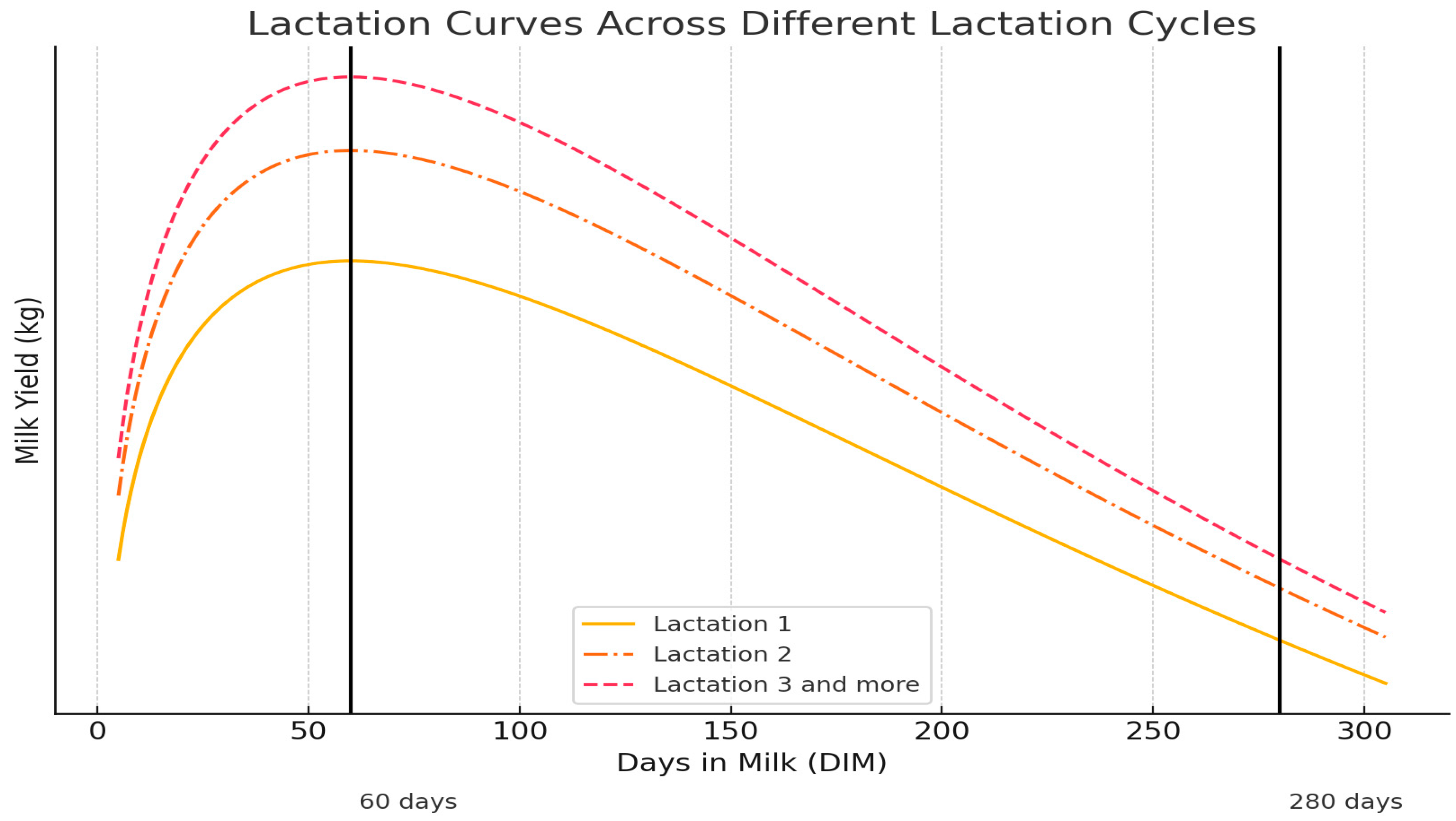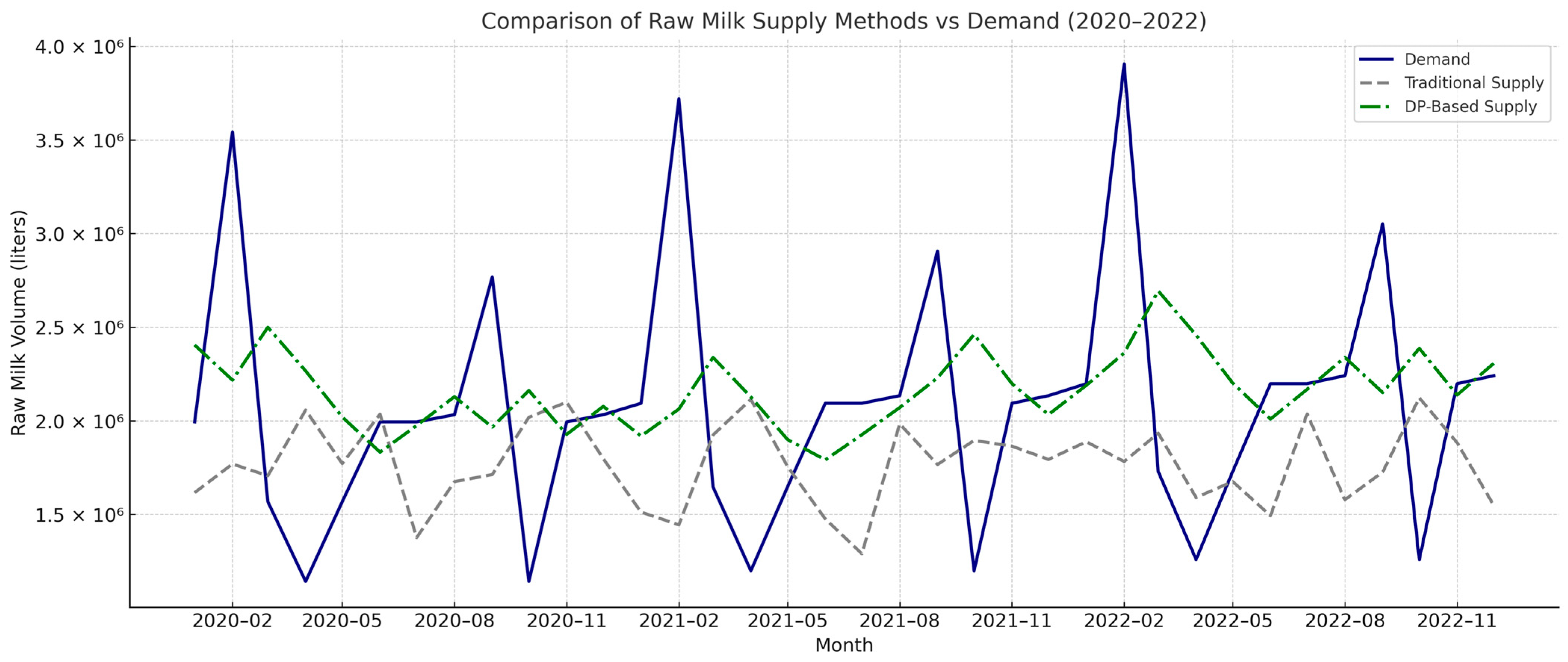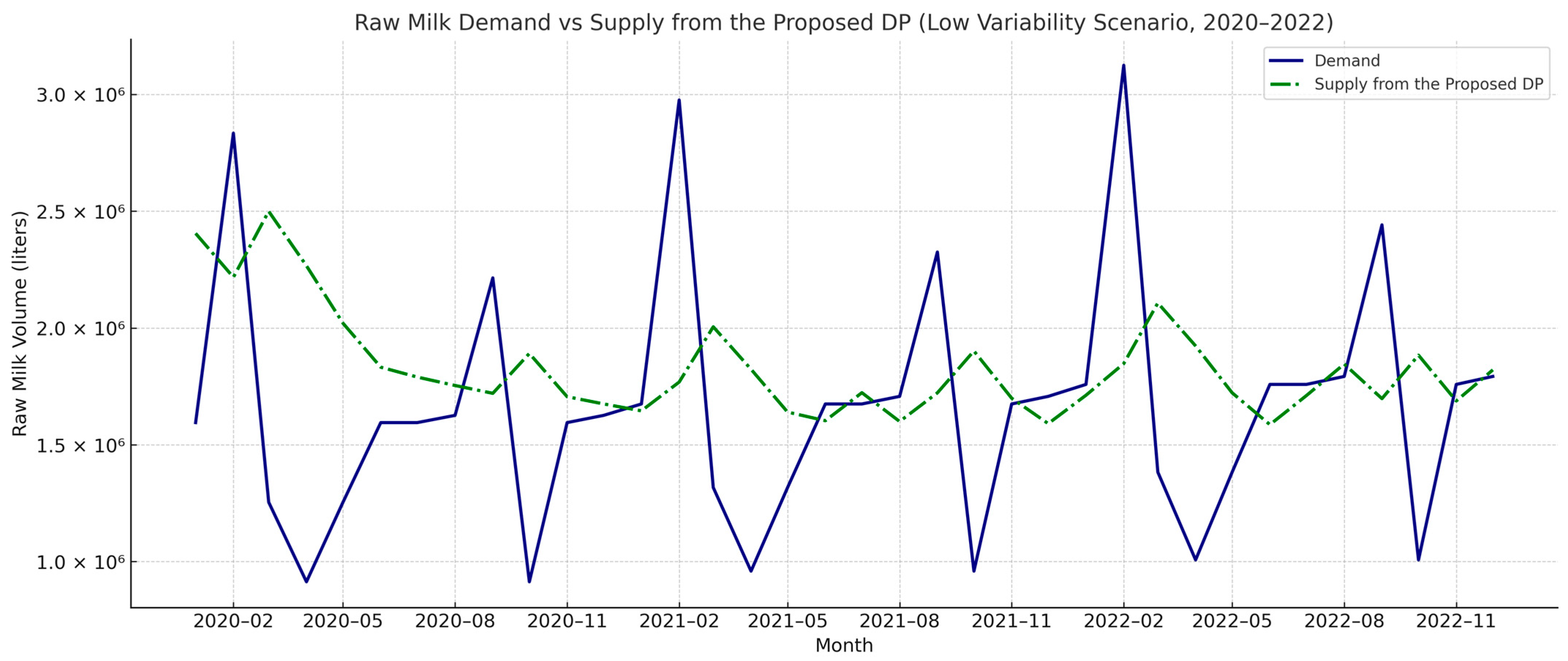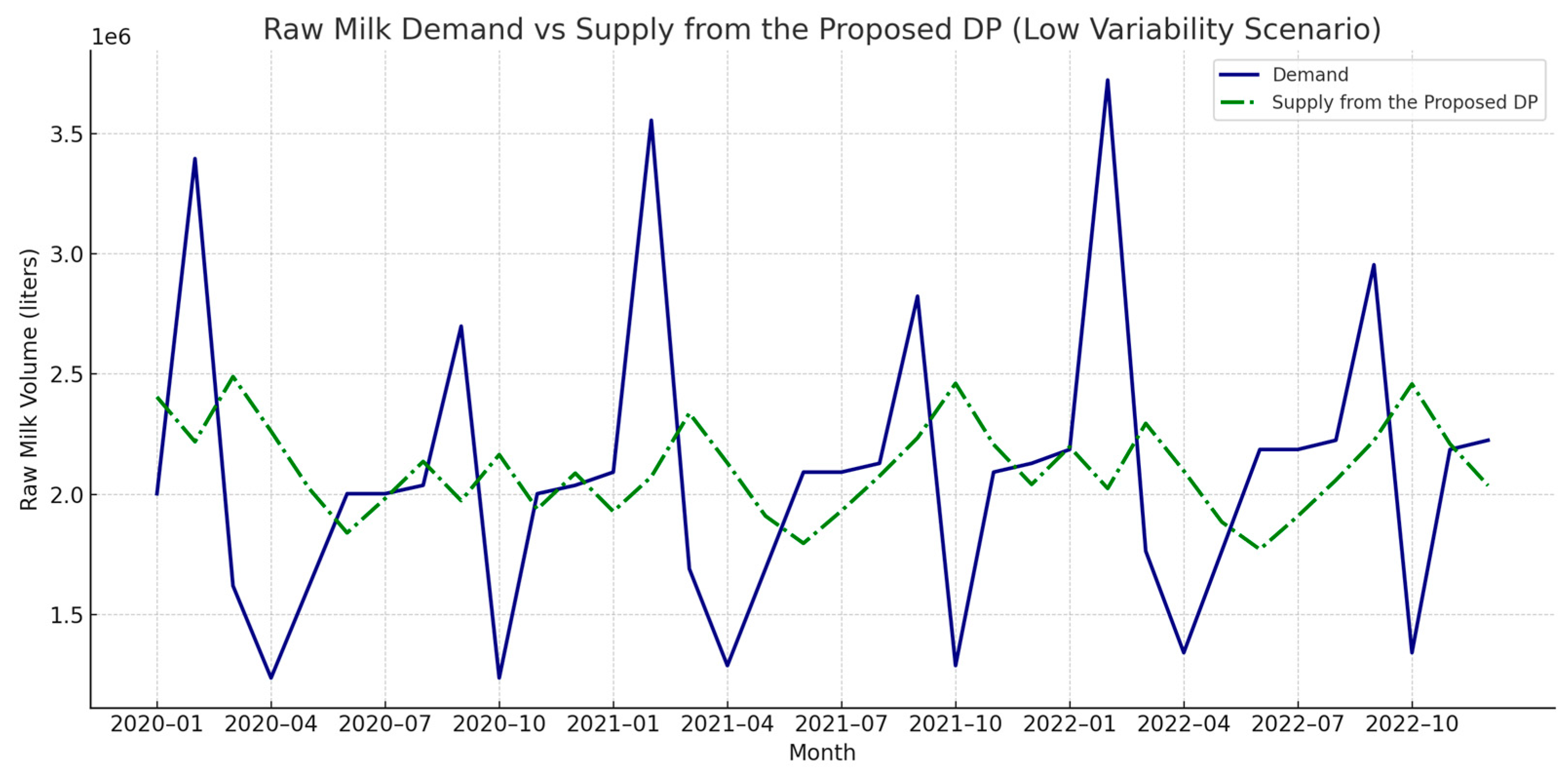Enhancing Sustainable Herd Structure Management in Thai Dairy Cooperatives Through Dynamic Programming Optimization
Abstract
1. Introduction
2. Methodology
2.1. Problem Description
2.2. Dairy Herd Management with Dynamic Programming
2.2.1. Notation and Indices
- Indices
- : Index of age of cattle ;
- : Index of month ;
- : Index of lactation Cycle = ;
- : Index of month-in-milk number ;
- : Index of gestational age ;
2.2.2. Decision Variables for Heifers Aged Between 0–14 Months Old (State I)
- Main decision variables
- : Number of heifers with the age of bought in month ;
- : Number of heifers with the age of sold in month ;
- Corresponding variables
- : Number of heifers with the age of at the end of month ;
- : Number of newborn heifers from first pregnant heifers in month ;
- : Number of newborn heifers from cows in month ;
2.2.3. Decision Variables and Parameters for Heifers Aged Between 15–18 Months Old (State II)
- Main decision Variables
- : Number of heifers with the age of bought in month ;
- : Number of heifers with the age of sold in month .
- Corresponding variables
- : Number of heifers with the age of at the end of month ;
- : Number of month-old heifers with pregnancy success in month .
- Parameters
- : Pregnancy success rate of heifer at the age .
2.2.4. Decision Variables and Parameters for First Pregnant Heifers Aged Between 16–27 Months Old (State III)
- Main decision variables
- : Number of first pregnant heifers at the age of with the current gestational age of bought in month ;
- : Number of first pregnant heifers at the age of with the current gestational age of sold in month .
- Corresponding variables
- : Number of first pregnant heifers at the age of with the current gestational age of at the end of month ;
- : Number of cows at the age of in month with milking month and lactation cycle ;
- : Expected number of newborn heifers from first pregnant heifers in month ;
- : Expected number of newborn bulls from first pregnant heifers in month ;
- : Expected number of miscarried heifers at the age of with the current gestational age of .
- Parameters
- : Female newborn rate by AI;
- : Abortion rate of a heifer with the gestational age of .
2.2.5. Decision Variables and Parameters for Non-Pregnant Milking Cow Aged Between 24–60 Months Old (State IV)
- Main decision variables
- : Number of cows at the age of bought in month with milking month and lactation cycle ;
- : Number of cows at the age of sold in month with milking month and lactation cycle .
- Corresponding variables
- : Number of cows at the age of at the end of month with milking month and lactation cycle ;
- : Number of cows at the age of in month with the current gestational age of , milking month , and lactation cycle ;
- : Number of cows with pregnancy success at the age of in month with the current milking month and lactation cycle;
- : Number of cows culled due to infertility or maximal cycle reached in month ;
- : Total expected number of miscarried cows at the age of in month with milking month and lactation cycle .
- Parameters
- : Pregnancy success rate of a cow with parity in the milking month .
2.2.6. Decision Variables and Parameters for Pregnant Milking Cow Aged Between 27–97 Months Old (State V)
- Decision Variables
- Main decision variables
- : Number of cows at the age of bought in month with the current gestational age of , milking month , and lactation cycle ;
- : Number of cows at the age of sold in month with the current gestational age of , milking month , and lactation cycle .
- Corresponding Variables
- : Number of cows at the age of at the end of month with milking month and lactation cycle ;
- : Number of cows at the age of in month with the current gestational age of , milking month , and lactation cycle ;
- : Expected number of newborn heifers from milking cow in month ;
- : Expected number of newborn bulls from milking cow in month ;
- : Total expected number of miscarried cows at the age of in month with milking month and lactation cycle ;
- : Expected number of miscarried cows the age of in month with the current gestational age of , milking month , and lactation cycle .
- Parameters
- : Female newborn rate by AI;
- : Milking cow abortion rate at the current gestational age of and lactation cycle ;
- : Milk yield of a cow with parity in the milking month , where .
2.2.7. Dynamic Programming
- Stage: Month (t).
- State: Number of dairy cows of various ages and stages at a given time, and status of dairy cows at month t.
- Transformation Function: .
- Recursion Function:
- Constraints
3. Computational Experiments
3.1. Experimental Results Based on the Current Scenario
3.2. Experimental Results Based on the Simulated Scenarios
3.2.1. High-Demand Scenario
3.2.2. Low-Demand Scenario
3.2.3. High-Variability Demand Scenario
3.2.4. Low-Variability Demand Scenario
4. Managerial Advantages and Discussion
4.1. Implications for Dairy Cooperatives in Developing Countries
4.2. Aspects Impacting Herd Stability and Sustainability
4.3. Enabling Smart Farming Integration: Opportunities and Challenges
4.4. Limitations of the Model, Feasibility of Implementation, and Areas for Future Development
5. Conclusions
Supplementary Materials
Author Contributions
Funding
Institutional Review Board Statement
Informed Consent Statement
Data Availability Statement
Acknowledgments
Conflicts of Interest
References
- Foreign Agricultural Service. U.S. Department of Agriculture. Dairy Production and Consumption in Thailand. 2021. Available online: https://fas.usda.gov/data/production/commodity-group/dairy (accessed on 13 March 2025).
- Kumar, V.; Wankhede, K.; Gena, H. Role of cooperatives in improving livelihood of farmers on sustainable basis. Am. J. Educ. Res. 2015, 3, 1258–1266. [Google Scholar] [CrossRef]
- Hooks, T.; McCarthy, O.; Power, C.; Macken-Walsh, Á. A co-operative business approach in a values-based supply chain: A case study of a beef co-operative. J. Co-Oper. Organ. Manag. 2017, 5, 65–72. [Google Scholar] [CrossRef]
- Jitmun, T.; Kuwornu, J.K.; Datta, A.; Anal, A.K. Factors influencing membership of dairy cooperatives: Evidence from dairy farmers in Thailand. J. Co-Oper. Organ. Manag. 2020, 8, 100109. [Google Scholar] [CrossRef]
- Koonawootrittriron, S.; Elzo, M.; Yeamkong, S.; Suwanasopee, T. A comparative study on dairy production and revenue of the dairy farms supported by a dairy cooperative with those supported by a private organization in Central Thailand. Livest. Res. Rural Dev. 2012, 24, 1–14. [Google Scholar]
- Aiumlamai, S.; Kreausukon, K.; Wongnen, N. Dairy production and the marketing system in Thailand. Planning Dairy Development Programs in Asia. In Proceedings of the 15th AAAP Congress, Bangkok, Thailand, 29 November 2012. [Google Scholar]
- Seifu, E.; Doluschitz, R. Analysis of the dairy value chain: Challenges and opportunities for dairy development in Dire Dawa, Eastern Ethiopia. Int. J. Agric. Policy Res. 2014, 2, 224–233. [Google Scholar] [CrossRef]
- Abdulsamad, A.; Gereffi, G. Dairy value chains in East Africa. Duke Center on Globalization, Governance & Competitiveness. 2016. Available online: https://www.globalvaluechains.org/wp-content/uploads/IGCDairyAfrica2016.pdf (accessed on 13 March 2025).
- Karunathilake, E.; Le, A.T.; Heo, S.; Chung, Y.S.; Mansoor, S. The path to smart farming: Innovations and opportunities in precision agriculture. Agriculture 2023, 13, 1593. [Google Scholar] [CrossRef]
- Walter, A.; Finger, R.; Huber, R.; Buchmann, N. Smart farming is key to developing sustainable agriculture. Proc. Natl. Acad. Sci. USA 2017, 114, 6148–6150. [Google Scholar] [CrossRef]
- Senarath, N.; Sungkhapreecha, P.; Buaban, S.; Chankitisakul, V.; Boonkum, W. Integrating genomic selection for rapid improvement of milk yield in small-scale dairy farms. Appl. Anim. Sci. 2022, 38, 246–251. [Google Scholar] [CrossRef]
- Vajirabhoga, V.; Sutiwartnarueput, K.; Pornchaiwiseskul, P. Factors affecting supply chain collaboration in Thailand’s dairy industry: Pilot study. Utopía Prax. Latinoam. Rev. Int. Filos. Iberoam. Teoría Soc. 2021, 26, 183–196. [Google Scholar]
- Rathod, P.K.; Dixit, S. Precision dairy farming: Opportunities and challenges for India. Indian J. Anim. Sci. 2020, 90, 1083–1094. [Google Scholar] [CrossRef]
- Said Mohamed, E.; Belal, A.A.; Kotb Abd-Elmabod, S.; El-Shirbeny, M.A.; Gad, A.; Zahran, M.B. Smart farming for improving agricultural management. Egypt. J. Remote Sens. Space Sci. 2021, 24, 971–981. [Google Scholar] [CrossRef]
- Gupta, M.; Abdelsalam, M.; Khorsandroo, S.; Mittal, S. Security and privacy in smart farming: Challenges and opportunities. IEEE Access 2020, 8, 34564–34584. [Google Scholar] [CrossRef]
- Murphy, T.; Tisdell, C. An Overview of Trends and Developments in the Thai Dairy Industry; Discussion Paper No. 178; Department of Economics, University of Queensland: Brisbane, Australia, 1996. [Google Scholar] [CrossRef]
- Gleeson, L.J. A review of the status of foot and mouth disease in South-East Asia and approaches to control and eradication. Rev. Sci. Tech. 2002, 21, 465–475. [Google Scholar] [CrossRef]
- Neave, H.; Costa, J.; Weary, D.; Von Keyserlingk, M. Long-term consistency of personality traits of cattle. R. Soc. Open Sci. 2020, 7, 191849. [Google Scholar] [CrossRef]
- LeBlanc, S.J.; Lissemore, K.D.; Kelton, D.F.; Duffield, T.F.; Leslie, K.E. Major advances in disease prevention in dairy cattle. J. Dairy. Sci. 2006, 89, 1267–1279. [Google Scholar] [CrossRef]
- Rhone, J.; Koonawootrittriron, S.; Elzo, M. A survey of decision making practices, educational experiences, and economic performance of two dairy farm populations in Central Thailand. Trop. Anim. Health Prod. 2008, 40, 475–482. [Google Scholar] [CrossRef]
- De Vries, A.; Marcondes, M. Overview of factors affecting productive lifespan of dairy cows. Animal 2020, 14, 155–164. [Google Scholar] [CrossRef]
- Wood, P. Algebraic model of the lactation curve in cattle. Nature 1967, 216, 164–165. [Google Scholar] [CrossRef]
- Wood, P. Factors affecting the shape of the lactation curve in cattle. Anim. Sci. 1969, 11, 307–316. [Google Scholar] [CrossRef]
- Silvestre, A.; Martins, A.; Santos, V.; Ginja, M.; Colaço, J. Lactation curves for milk, fat and protein in dairy cows: A full approach. Livest. Sci. 2009, 122, 308–313. [Google Scholar] [CrossRef]
- Jattawa, D.; Elzo, M.A.; Koonawootrittriron, S.; Suwanasopee, T. Comparison of genetic evaluations for milk yield and fat yield using a polygenic model and three genomic–polygenic models with different sets of SNP genotypes in Thai multibreed dairy cattle. Livest. Sci. 2015, 181, 58–64. [Google Scholar] [CrossRef]
- Harder, I.; Stamer, E.; Junge, W.; Thaller, G. Lactation curves and model evaluation for feed intake and energy balance in dairy cows. J. Dairy. Sci. 2019, 102, 7204–7216. [Google Scholar] [CrossRef] [PubMed]
- Abdelkrim, A.B.; Puillet, L.; Gomes, P.; Martin, O. Lactation curve model with explicit representation of perturbations as a phenotyping tool for dairy livestock precision farming. Animal 2021, 15, 100074. [Google Scholar] [CrossRef] [PubMed]
- Solodneva, E.; Smolnikov, R.; Bazhenov, S.; Vorobyeva, D.; Stolpovsky, Y.A. Lactation curves as a tool for monitoring the health and performance of dairy cows-a mini-review. J. Agricult. Biol. 2022, 57, 257–271. [Google Scholar] [CrossRef]
- Collins-Lusweti, E. Lactation curves of Holstein-Friesian and Jersey cows in Zimbabwe. S. Afr. J. Anim. Sci. 1991, 21, 11–15. [Google Scholar]
- Dobson, H.; Smith, R.; Royal, M.; Knight, C.; Sheldon, I. The high-producing dairy cow and its reproductive performance. Reprod. Domest. Anim. 2007, 42, 17–23. [Google Scholar] [CrossRef]
- M’Hamdi, N.; Darej, C.; Attia, K.; Znaidi, I.E.A.; Khattab, R.; Djelailia, H.; Bouraoui, R.; Taboubi, R.; Marzouki, L.; Ayadi, M. Modelling THI effects on milk production and lactation curve parameters of Holstein dairy cows. J. Therm. Biol. 2021, 99, 102917. [Google Scholar] [CrossRef]
- Thammacharoen, S.; Chanpongsang, S.; Chaiyabutr, N.; Teedee, S.; Pornprapai, A.; Insam-Ang, A.; Srisa-Ard, C.; Channacoop, N. An analysis of a herd-based lactation curve reveals the seasonal effect from dairy cows fed under high ambient temperatures. Thai J. Vet. Med. 2020, 50, 169–178. [Google Scholar] [CrossRef]
- Cozzi, G.; Ravarotto, L.; Gottardo, F.; Stefani, A.; Contiero, B.; Moro, L.; Brscic, M.; Dalvit, P. Reference values for blood parameters in Holstein dairy cows: Effects of parity, stage of lactation, and season of production. J. Dairy Sci. 2011, 94, 3895–3901. [Google Scholar] [CrossRef]
- Koonawootrittriron, S.; Elzo, M.A.; Tumwasorn, S. Multibreed genetic parameters and predicted genetic values for first lactation 305-d milk yield, fat yield, and fat percentage in a bos taurus X bos indicus multibreed dairy population in Thailand. Thai J. Agric. Sci. 2002, 35, 339–360. [Google Scholar]
- Wongpom, B.; Koonawootrittriron, S.; Elzo, M.A.; Suwanasopee, T. Milk yield, fat yield and fat percentage associations in a Thai multibreed dairy population. Agric. Nat. Resour. 2017, 51, 218–222. [Google Scholar] [CrossRef]
- Gloy, B.A.; Hyde, J.; LaDue, E.L. Dairy farm management and long-term farm financial performance. Agric. Resour. Econ. Rev. 2002, 31, 233–247. [Google Scholar] [CrossRef]
- Veerkamp, R.F. Selection for economic efficiency of dairy cattle using information on live weight and feed intake: A review. J Dairy Sci 1998, 81, 1109–1119. [Google Scholar] [CrossRef] [PubMed]
- Oltenacu, P.A.; Broom, D.M. The impact of genetic selection for increased milk yield on the welfare of dairy cows. Anim. Welf. 2010, 19, 39–49. [Google Scholar] [CrossRef]
- Sarttra, T.; Kittitanasak, K.; Wongwaitayakul, K.; Phaophu, C.; Kiatcharoenpol, T. An optimal approach for supply and demand management with the consideration of cattle herd structure management: A case study of medium-size dairy cooperative in Thailand. Comput. Ind. Eng. 2023, 182, 109355. [Google Scholar] [CrossRef]
- Chukwumuanya, E.; Uchendu, S.E.; Okpala, C.C.; Ezechi, D.J. The Optimization of Poultry Farm Production Planning for Maximum Returns Using Mixed-Integer Linear Programming Approach. Int. J. Ind. Prod. Eng. 2024, 2, 1–14. [Google Scholar]
- Solano-Blanco, A.L.; González, J.E.; Gómez-Rueda, L.O.; Vargas-Sánchez, J.J.; Medaglia, A.L. Integrated planning decisions in the broiler chicken supply chain. Int. Trans. Oper. Res. 2023, 30, 1931–1954. [Google Scholar] [CrossRef]
- Solano Blanco, A.L. Integrated Planning in the Poultry Supply Chain Under Uncertainty. Master’s Thesis, Universidad de los Andes, Bogotá, Colombia, 2023. Available online: https://repositorio.uniandes.edu.co/handle/1992/48639 (accessed on 13 March 2025).
- Brevik, E.; Lauen, A.Ø.; Rolke, M.C.; Fagerholt, K.; Hansen, J.R. Optimisation of the broiler production supply chain. Int. J. Prod. Res. 2020, 58, 5218–5237. [Google Scholar] [CrossRef]
- Huirne, R.; Dijkhuizen, A.; Van Beek, P.; Renkema, J. Dynamic programming to optimize treatment and replacement decisions. In Animal Health Economics: Principles and Applications, Post Graduate Foundation in Veterinary Science; University of Sydney: Sydney, NSW, Australia, 1997; pp. 85–98. [Google Scholar]
- Rajala-Schultz, P.J.; Grohn, Y.T.; Allore, H.G. Optimizing replacement decisions for Finnish dairy herds. Acta. Vet. Scand. 2000, 41, 185–198. [Google Scholar] [CrossRef]
- DeLorenzo, M.A.; Spreen, T.H.; Bryan, G.R.; Beede, D.K.; Van Arendonk, J.A. Optimizing model: Insemination, replacement, seasonal production, and cash flow. J. Dairy. Sci. 1992, 75, 885–896. [Google Scholar] [CrossRef]
- Stewart, H.; Burnside, E.; Wilton, J.; Pfeiffer, W. A dynamic programming approach to culling decisions in commercial dairy herds. J. Dairy Sci. 1977, 60, 602–617. [Google Scholar] [CrossRef]
- Shrestha, B.; Paudyal, S.; Kaniyamattam, K.; Grohn, Y.T. Organic Dairy Cattle Longevity and Economic Implications: Contemporary Perspectives. J. Dairy. Sci. 2025, 108, 3734–3745. [Google Scholar] [CrossRef] [PubMed]
- Seyedsharifi, R.; Amiri, S.; Hedayat-Evrigh, N.; Seifdavati, J.; Yalchi, T. Investigation of Maximizing Profit in Dairy Herds with Production System Optimization Approach. Anim. Sci. Res. 2021, 31, 27–39. [Google Scholar] [CrossRef]
- Haine, D.; Delgado, H.; Cue, R.; Sewalem, A.; Wade, K.; Lacroix, R.; Lefebvre, D.; Arsenault, J.; Bouchard, E.; Dubuc, J. Culling from the herd’s perspective-Exploring herd-level management factors and culling rates in Quebec dairy herds. Prev. Vet. Med. 2017, 147, 132–141. [Google Scholar] [CrossRef]











| Indicator | Traditional | DP-Based | Decrement Percentage (Improvement) |
|---|---|---|---|
| Maximum Change in Total Herd Size | 135 | 72 | ↓ 46.7% |
| Standard Deviation of Herd Size | 45.6 | 23.5 | ↓ 48.5% |
| Culling Rate per Year | 29% | 22% | ↓ 7% |
| Replacement Rate per Year | 30% | 25% | ↓ 5% |
Disclaimer/Publisher’s Note: The statements, opinions and data contained in all publications are solely those of the individual author(s) and contributor(s) and not of MDPI and/or the editor(s). MDPI and/or the editor(s) disclaim responsibility for any injury to people or property resulting from any ideas, methods, instructions or products referred to in the content. |
© 2025 by the authors. Licensee MDPI, Basel, Switzerland. This article is an open access article distributed under the terms and conditions of the Creative Commons Attribution (CC BY) license (https://creativecommons.org/licenses/by/4.0/).
Share and Cite
Sarttra, T.; Kiatcharoenpol, T. Enhancing Sustainable Herd Structure Management in Thai Dairy Cooperatives Through Dynamic Programming Optimization. Sustainability 2025, 17, 3894. https://doi.org/10.3390/su17093894
Sarttra T, Kiatcharoenpol T. Enhancing Sustainable Herd Structure Management in Thai Dairy Cooperatives Through Dynamic Programming Optimization. Sustainability. 2025; 17(9):3894. https://doi.org/10.3390/su17093894
Chicago/Turabian StyleSarttra, Thana, and Tossapol Kiatcharoenpol. 2025. "Enhancing Sustainable Herd Structure Management in Thai Dairy Cooperatives Through Dynamic Programming Optimization" Sustainability 17, no. 9: 3894. https://doi.org/10.3390/su17093894
APA StyleSarttra, T., & Kiatcharoenpol, T. (2025). Enhancing Sustainable Herd Structure Management in Thai Dairy Cooperatives Through Dynamic Programming Optimization. Sustainability, 17(9), 3894. https://doi.org/10.3390/su17093894






